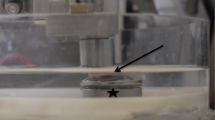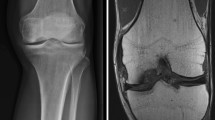Abstract
Purpose
To compare the mechanical stress applied to our grafted defect area according to the diameter of the plugs used in the treatment of osteochondral lesion with osteochondral autograft transplantation (OAT) procedure.
Methods
A biomechanical study was conducted on eight cadaveric knees. A 20-mm defect was created in the weight-bearing zone on the medial femoral condyle then filled either with three plugs of 8 mm, or with four plugs of 6 mm, or with 6 plugs of 4 mm diameter. After the preparation of the specimens, each knee was installed on a mechanical test bench (Instron 5566A). A continuous axial compression of 700 N at 10 mm.min−1 was exerted on the joint. A K-scan 4000-type pressure sheet was used to record the contact area (mm2), the mean pressure (MPa), and the maximum pressure (MPa) on the area of interest.
Results
The differences found between the conditions were not statistically significant but showed tendencies. Filling the defect with six plugs of 4 mm restores a larger contact surface compared with the other plugs. The use of 8- and 6-mm grafts lead to a respective increase of 12% and 52% of the mean pressure compared with the 4 mm grafts. This difference was also found for the maximum pressure (36% and 129%). Regardless of the diameter of the plugs used, filling the lesion reduces the mean pressure exerted on the healthy cartilage by 19%.
Discussion
A trend emerged towards a better restoration of the cartilage surface and a more harmonious distribution of the pressures exerted in favour of the grafts of smaller diameter. A larger study is needed to obtain a statistically significant result.






Similar content being viewed by others
Code availability
Not applicable.
Data availability
The data that support the findings of this study are available from the corresponding author.
References
Hulet C, Flurin PH (2014) Techniques en arthroscopie du membre inférieur: Monographie SOFCOT. Elsevier Masson
Di Martino A, Silva S, Andriolo L et al (2021) Osteochondral autograft transplantation versus autologous bone-cartilage paste grafting for the treatment of knee osteochondritis dissecans. Int Orthop 45:453–461. https://doi.org/10.1007/s00264-020-04804-6
Falah M, Nierenberg G, Soudry M et al (2010) Treatment of articular cartilage lesions of the knee. Int Orthop 34:621–630. https://doi.org/10.1007/s00264-010-0959-y
Inderhaug E, Solheim E (2019) Osteochondral autograft transplant (mosaicplasty) for knee articular cartilage defects. JBJS Essent Surg Tech 9(e34):1–2. https://doi.org/10.2106/JBJS.ST.18.00113
Kizaki K, El-Khechen HA, Yamashita F et al (2021) Arthroscopic versus open osteochondral autograft transplantation (mosaicplasty) for cartilage damage of the knee: a systematic review. J Knee Surg 34:94–107. https://doi.org/10.1055/s-0039-1692999
Hangody L, Kish G, Kárpáti Z et al (1997) Arthroscopic autogenous osteochondral mosaicplasty for the treatment of femoral condylar articular defects. A preliminary report. Knee Surg Sports Traumatol Arthrosc 5:262–267. https://doi.org/10.1007/s001670050061
Guettler JH, Demetropoulos CK, Yang KH, Jurist KA (2004) Osteochondral defects in the human knee: influence of defect size on cartilage rim stress and load redistribution to surrounding cartilage. Am J Sports Med 32:1451–1458. https://doi.org/10.1177/0363546504263234
Brown TD, Pope DF, Hale JE et al (1991) Effects of osteochondral defect size on cartilage contact stress. J Orthop Res 9:559–567. https://doi.org/10.1002/jor.1100090412
Koh JL, Wirsing K, Lautenschlager E, Zhang L-O (2004) The effect of graft height mismatch on contact pressure following osteochondral grafting: a biomechanical study. Am J Sports Med 32:317–320. https://doi.org/10.1177/0363546503261730
Kock NB, Smolders JMH, van Susante JLC et al (2008) A cadaveric analysis of contact stress restoration after osteochondral transplantation of a cylindrical cartilage defect. Knee Surg Sports Traumatol Arthrosc 16:461–468. https://doi.org/10.1007/s00167-008-0494-1
Koh JL, Kowalski A, Lautenschlager E (2006) The effect of angled osteochondral grafting on contact pressure: a biomechanical study. Am J Sports Med 34:116–119. https://doi.org/10.1177/0363546505281236
Nakagawa Y, Suzuki T, Kuroki H et al (2007) The effect of surface incongruity of grafted plugs in osteochondral grafting: a report of five cases. Knee Surg Sports Traumatol Arthrosc 15:591–596. https://doi.org/10.1007/s00167-006-0253-0
Zhim F, Laflamme GY, Viens H et al (2005) Biomechanical stability of high tibial opening wedge osteotomy: internal fixation versus external fixation. Clin Biomech (Bristol, Avon) 20:871–876. https://doi.org/10.1016/j.clinbiomech.2005.04.008
Hangody L, Vásárhelyi G, Hangody LR et al (2008) Autologous osteochondral grafting–technique and long-term results. Injury 39(Suppl 1):S32-39. https://doi.org/10.1016/j.injury.2008.01.041
Hangody L, Füles P (2003) Autologous osteochondral mosaicplasty for the treatment of full-thickness defects of weight-bearing joints : Ten Years of Experimental and Clinical Experience. JBJS 85:25
Choung D, Christensen JC (2002) Mosaicplasty of the talus: a joint contact analysis in a cadaver model. J Foot Ankle Surg 41:65–75. https://doi.org/10.1016/s1067-2516(02)80030-8
Robert H (2013) Techniques de réparation du cartilage du genou par plastie en mosaïque: chondral repair of the knee joint with mosaicplasty. In 18 mises au point en chirurgie du genou. Elsevier Masson, pp 103–119
Ahmad CS, Guiney WB, Drinkwater CJ (2002) Evaluation of donor site intrinsic healing response in autologous osteochondral grafting of the knee. Arthrosc 18:95–98. https://doi.org/10.1053/jars.2002.25967
Kock NB, Van Susante JLC, Buma P et al (2006) Press-fit stability of an osteochondral autograft: Influence of different plug length and perfect depth alignment. Acta Orthop 77:422–428. https://doi.org/10.1080/17453670610046352
Kordás G, Szabó JS, Hangody L (2006) Primary stability of osteochondral grafts used in mosaicplasty. Arthrosc 22:414–421. https://doi.org/10.1016/j.arthro.2005.12.011
Author information
Authors and Affiliations
Contributions
All authors contributed to the study’s conception and design.
Material preparation, data collection, and analysis were performed by A. Caubère, F. Roseren, and G. Aullo-Rasser.
The first draft of the manuscript was written by A. Caubère and all authors commented on previous versions of the manuscript.
All authors read and approved the final manuscript.
Corresponding author
Ethics declarations
Ethics approval
Approved by the Hospital and the Laboratory Ethics Committee.
Consent to participate
Not applicable.
Consent for publication
Not applicable.
Conflict of interest
The authors declare no competing interests.
Additional information
Publisher's note
Springer Nature remains neutral with regard to jurisdictional claims in published maps and institutional affiliations.
Rights and permissions
Springer Nature or its licensor (e.g. a society or other partner) holds exclusive rights to this article under a publishing agreement with the author(s) or other rightsholder(s); author self-archiving of the accepted manuscript version of this article is solely governed by the terms of such publishing agreement and applicable law.
About this article
Cite this article
Caubère, A., Roseren, F., Aullo-Rasser, G. et al. Osteochondral autograft transplantation (mosaicplasty): What is the impact of plug diameter in cartilage repair?. International Orthopaedics (SICOT) 47, 623–630 (2023). https://doi.org/10.1007/s00264-022-05686-6
Received:
Accepted:
Published:
Issue Date:
DOI: https://doi.org/10.1007/s00264-022-05686-6




